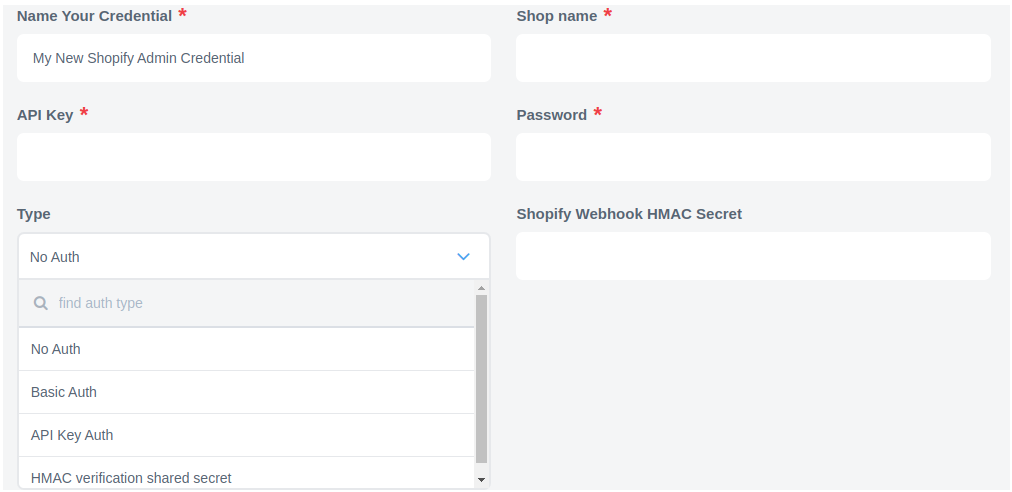Shopify
This component lets you build integrations that extend and enhance the Shopify admin.
Follow these instructions to learn how to integrate the Shopify store with your Digital Experience Platform applications: https://docs.squiz.net/matrix/version/latest/tutorials/integrations/use-shopify-to-sell-products-through-your-site.html.
Prerequisites
Credentials

- ShopName
-
The name of your shop. For example,
example.myshopify.com. - API Key
-
The API key you generated in the Shopify admin area.
- Password
-
The API password that you generated.
- Type
-
An authorization type. This is needed only for the Webhook subscription trigger. The following authorization types support it:
- No Auth
-
Use this method to work with any open REST API.
- Basic Auth
-
Use this method to provide sign-in credentials like username and password.
- API Key Auth
-
Use this method to provide API Key to access the resource.
- HMAC verification shared secret
-
Use this to verify through a shared secret. The
x-eio-signatureheader should be specified.
|
Metafields
Metafields for an object can be written when upserting/creating an object that supports metafields. When polling for objects, looking up, or searching for objects, a checkbox can be selected to fetch the corresponding metafields. Selecting this checkbox will cause more API calls to be consumed (an additional API call is made for each object read.)
When reading metafields, data will be returned in this format.
When writing metafield data, the following format is also expected for the metafields object.
{
"metafieldNamespaceOne": {
"metafieldKeyOne": "Metafield Value for metafieldNamespaceOne.metafieldKeyOne",
"metafieldKeyTwo": "Metafield Value for metafieldNamespaceOne.metafieldKeyTwo"
},
"metafieldNamespaceTwo": {
"metafieldKeyThree": "Metafield Value for metafieldNamespaceTwo.metafieldKeyThree"
}
}Shopify metafields support the following three types:
-
integermetafields will be created whenever the value provided for a metafield is a JSON number that is an integer. When reading Shopify integer metafields, they will result in JSON numbers. -
stringmetafields will be created whenever the value provided for a metafield is a JSON string or a JSON number that is not an integer. When reading any Shopify string metafields, they will result in JSON strings regardless of whether or not they could be parsed as numbers. -
json_stringmetafields will be created whenever the value provided for a metafield is a JSON object, array, or boolean. The incoming value will be converted to a JSON string and stored. When reading Shopify metafields, they will be converted back to their JSON forms. Setting a metafield with the value of JSON null will result in that metafield being deleted.
Not setting a value for a metafield will result in that metafield being unchanged.
Triggers
The Shopify component has the following Shopify triggers
- Polling trigger
-
Polls Shopify API for new and updated objects.
- Webhook subscription trigger
-
Creates webhook subscriptions on the Shopify side and receives events to the flow.
Actions
Shopify component has the following Shopify actions:
- Lookup Object action
-
Finds object by ID.
- Lookup Objects action
-
Retrieves object by ID.
- Create Object action
-
Action to create a new object instance. This can only be used for an object that can’t be updated.
- Upsert Object action
-
Upsert Object action is helpful if it isn’t known if there is already an object in the system. Action determines if the data needs to be matched to an existing object or added to a new one. This can only be used for objects that can be created and updated.
- Delete Object action
-
Delete Object By Unique Criteria.
- Make Raw Request
-
Allows you to construct individual requests to be sent to the API manually.
